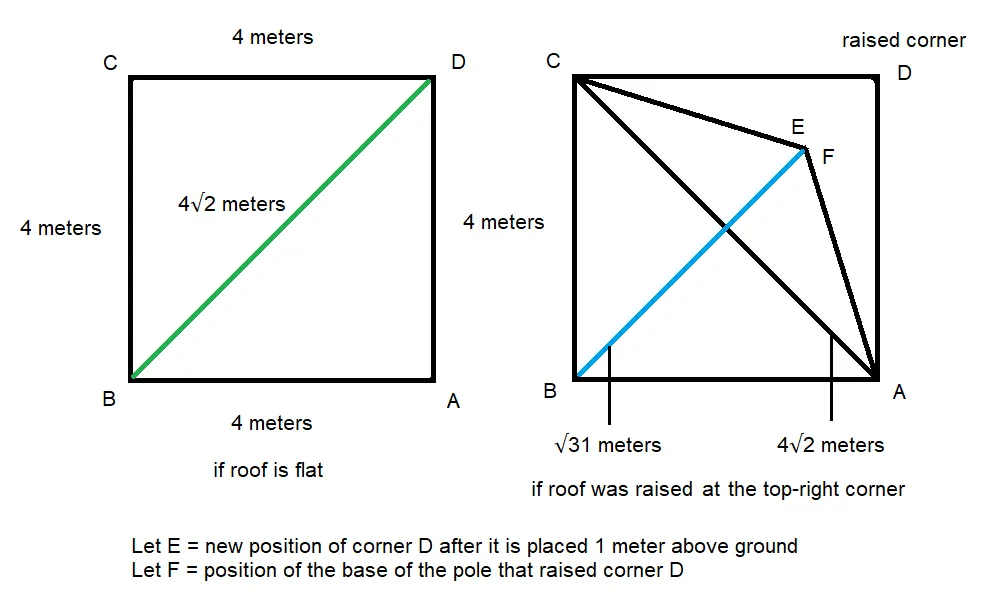Answer for Day 20 Math Problem
The problem does not have enough details to have a simple answer. 🎯😅
Solution
The original problem did not directly specify how far above the ground the square canvas roof is. Since the sun is overcast and very far away, moving the roof up several meters will not have a noticeable difference on the shadow formed (by the way, clothes on a clothesline should be placed higher to "dry faster because they are nearer the sun"). 😅 Therefore, we can assume that the 3 corners of the roof are attached to the ground (so the heights of the 3 corners are 0 meters).
Other information that are not explicitly shown in the given but are logically true for the Math problem:
- The sun is perpendicular to the ground.
The tarpaulin is not elastic. ("mathland" according to @eturnerx-dbuzz)- The roof is assumed to have zero thickness. (again, "mathland") 😅
However, the problem is that it is not specified whether the tarpaulin is can be bent or folded. Therefore, just any person capable of solving Math challenge problems can make his or her own scenario, then formulate an answer based on his or her preferred details.
We should use variables to refer to the points on the square.
- Let A, B, C, and D be the four corners of the square (arranged counterclockwise where A is at the bottom-right corner).
- Let E be the new position of the corner D when it is raised by 1 meter. It will also refer to the top of the pole that raised the corner.
- Let F be the new position of the base of the pole that raised the corner by 1 meter.
Our goal here is to be able to represent a kite representing the shade's produced shadow. The surface area of a kite is equal to the product of its diagonals divided by 2. The corners of the kite (arranged counterclockwise) should be ABCE, where AC and BE are the diagonals.
From the given data, we can now derive the following.
- Diagonal line segment BD (and AC) is 4√2 meters long, because the diagonal length of a square is always equal to its side multiplied by √2. When corner D is raised, the line segment is now referred to as segment BE. However, when corner D is raised, the answer depends on whether the canvas can be bent slightly, bent gradually, or stretched.
- The pole will be referred to as line segment EF, which is 1 meter long.
We now have a right triangle BEF where F is the right angle. We know that line segment BE is 4√2 meters and EF is 1 meter, so the missing length is line segment BF. We should use the Pythagorean Theorem to get BF, which is BF = √((BE)² - (EF)²) = √((4√2)² - 1²) = √31 meters. If the canvas cannot be folded, corners A and C will be pulled to D. It is up to the solver to continue solving from this.

Winner: @jfang003 🏅
1 HIVE has been sent to @jfang003's Hive account. 💰
Special awardee: @minus-pi 🎖️
For a fast and accurate reply for my solution, @minus-pi has also been awarded 1 HIVE. However, according to the rules, @minus-pi should have been active on D.Buzz for at least 7 days within the last 14 days to qualify as winner (next time), unless a user active on D.Buzz vouches for them.
Mentions: @ahmadmanga (@ahmadmangazap) and @holovision 🤔
Special mentions: @chrisrice and @jancharlest 🤯
